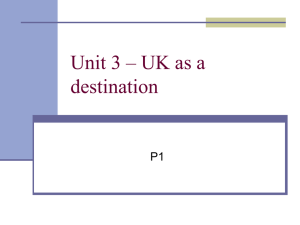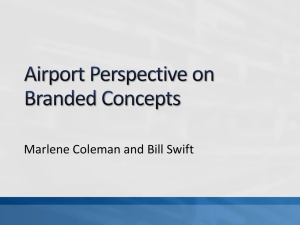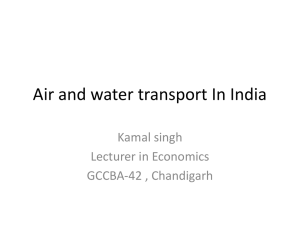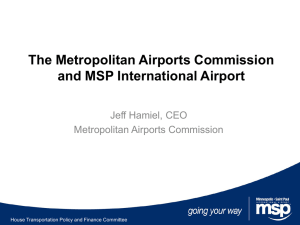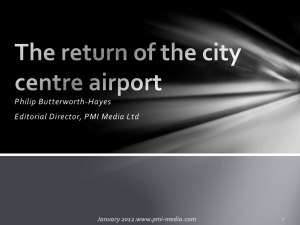Low carbon transport to airports project report
advertisement
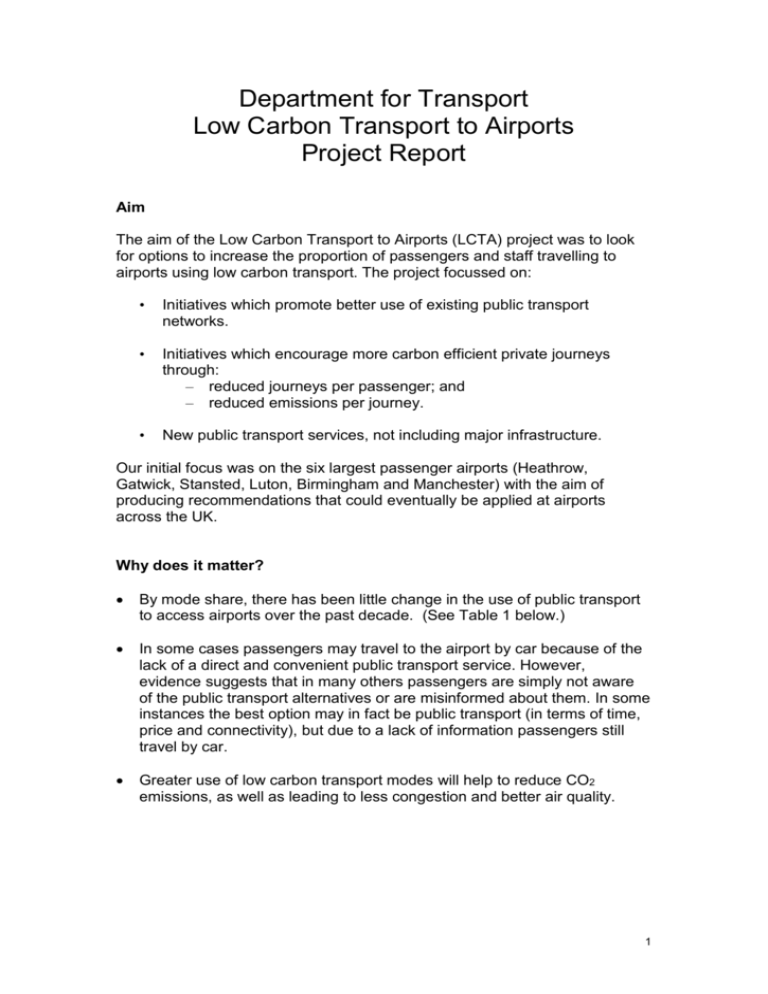
Department for Transport Low Carbon Transport to Airports Project Report Aim The aim of the Low Carbon Transport to Airports (LCTA) project was to look for options to increase the proportion of passengers and staff travelling to airports using low carbon transport. The project focussed on: • Initiatives which promote better use of existing public transport networks. • Initiatives which encourage more carbon efficient private journeys through: – reduced journeys per passenger; and – reduced emissions per journey. • New public transport services, not including major infrastructure. Our initial focus was on the six largest passenger airports (Heathrow, Gatwick, Stansted, Luton, Birmingham and Manchester) with the aim of producing recommendations that could eventually be applied at airports across the UK. Why does it matter? By mode share, there has been little change in the use of public transport to access airports over the past decade. (See Table 1 below.) In some cases passengers may travel to the airport by car because of the lack of a direct and convenient public transport service. However, evidence suggests that in many others passengers are simply not aware of the public transport alternatives or are misinformed about them. In some instances the best option may in fact be public transport (in terms of time, price and connectivity), but due to a lack of information passengers still travel by car. Greater use of low carbon transport modes will help to reduce CO2 emissions, as well as leading to less congestion and better air quality. 1 Table 1: Percentage of passengers who travelled to the airport using public transport: 2009 2008 2007 2006 Stansted 47% 46.9% 44.6% 39.6% Heathrow 40% 38% 38.4% 35.6% Gatwick 37% 36.2% 35.1% 35.4% Luton 33% 33.5% 29.9% 30.1% Birmingham 26.8% 24.3% 20.4% 19% Manchester 10.4% 10.8% 9.6% 11% Source: CAA Passenger Survey LCTA 2010 Workshop The Airport Operators’ Association (AOA) and the Department for Transport (DfT) jointly hosted a workshop on 3 February 2010. Participants were primarily surface access specialists from England’s largest airports. The workshop addressed two themes: encouraging the use of public transport; and encouraging the more efficient use of private transport, with both focusing on measures that would not require significant infrastructure investment. The aims of the workshop were to seek to understand: What the challenges were in promoting low carbon travel to airports, both across all airports and at each individual airport for passengers and for employees; What progress had been made since 2006, when the AOA and DfT had hosted a Surface Access Forum, and what challenges still remained; What could be done at each airport to address their specific challenges; What could be done across the industry to promote low carbon transport to airports; Who needed to take action to increase low carbon transport to airports; and The most effective next steps for taking this forward. 2 A range of possible initiatives to improve low carbon transport modal share was proposed at the 2010 workshop. The DfT and AOA reviewed all of the suggestions put forward and jointly identified three initiatives to take forward that they believed would be effective, relatively easy to implement, and would not require significant additional resources. Workstreams The three workstreams selected were: 1. Enabling passengers to make more informed journey decisions by encouraging airlines to provide public transport advice at the point of booking. 2. Advising business travellers about low carbon options by updating the existing travel planning guidance available on websites, such as the National Business Travel Network and Business Link. 3. Holding an annual forum, chaired by the DfT and AOA, to address surface access issues and support further innovation and best practice sharing across airports. Workstream 1: Better information to passengers, through airlines from the point of booking the ticket Using a variety of methods, the aim of this workstream was to enable more informed journey decisions for passengers by providing public transport advice on booking their ticket, prior to travel (when applying for visas, when tickets are posted, when registering passport details), at check-in and during the flight. On 26 November 2010 DfT met with airline representatives (from BA, TUI Travel, BAR UK and BATA) to discuss the proposal and secure their commitment to attend the 2011 forum. We also decided to broaden the scope of this workstream by considering which other organisations communicate with passengers prior to booking. This prompted us to link up with Visit Britain and Visit England, who are currently undertaking work designed to improve the level of information provided to foreign visitors to the UK. Elements of this strategy, such as the sale of Oyster cards in the USA to Americans about to visit the UK, involve promoting the available public transport options. Workstream 2: Advice to business travellers The current mechanisms for advising businesses on reducing the impacts of work-related travel (both commuting and business travel) is through the National Business Travel Network (NBTN) programme and website – particularly the ways2work campaign element called ‘Re-thinking Business 3 Travel’ and also DfT and Business Link websites. The aim of this workstream was to add guidance on airport access to these existing portals and also link through to the individual airports’ websites and the relevant pages. On 27 January DfT and NBTN met to identify future opportunities to promote low carbon surface access to airports for business travellers. The opportunities identified included making the most of the upcoming NBTN website overhaul, and adding a question/s on travel to and from airports to NBTN’s June 2011 Work-related Travel Survey. NBTN also highlighted existing good practice by organisations such as Legal Sector Alliance including Eversheds, Capgemini, BSKyB, E.ON, EDF, John Lewis and others which, as well as working to reduce all but essential business flights through sustainable travel and alternatives to travel (which also removes airport surface access impacts of those reduced flights), have policies in place that include the following: the use of low emissions taxis (such as Greentomatocars) the stipulation that public transport is required for access to airports with prior approval for taxi use should it be absolutely necessary low emissions company car fleets fuel efficient driving. All of these make a contribution to reducing the business traveller’s carbon impact when going to and from UK airports. Workstream 3: DfT and AOA to host a regular forum to share best practice on surface access issues The DfT and AOA held a joint forum on low carbon surface access at Gatwick Airport on 17 February 2011. Representatives from a range of organisations (airport operators, airlines, and others such as Visit England, NBTN, UKTI and an expert academic) shared examples of good practice that they had already developed and worked together in groups to consider what further initiatives could be launched in the future. The main message from the event was that it would be impossible for airport operators to achieve a significant change in passenger travel habits without the assistance of other organisations, e.g. airlines who also have influence over the passenger journey, and that greater engagement is needed at an airport specific level. For example, the establishment of the Heathrow Sustainability Partnership has enabled BAA to gain the buy-in of the CEOs of the majority of companies based at the airport to a range of environmental initiatives. Following the forum all attendees received copies of all the slides from the presentations, the completed good practice templates, and notes from the breakout sessions. 4 Next Steps The LCTA project has now been completed. Its core initiatives will be taken forward by the DfT and other stakeholders as follows: Surface access policy The Government is developing a sustainable framework for UK aviation. The first step was the publication of a scoping document on 30 March 2011, and this includes a question on surface access in the Local Impacts section – (5.42) Do you think that current arrangements for ensuring sustainable surface access to and from airports e.g. Airport Transport Forums and airport surface access strategies are effective? Could more be done to improve surface access and reduce its environmental impacts? If so, what and by whom? The scoping document can be found at: http://www.dft.gov.uk/consultations/open/2011-09/ All those who have previously contributed to the LCTA project are encouraged to respond with evidence to support their views. We have requested contributions by 30 September 2011. The proposal raised at the 2010 workshop to reduce the occurrence of ‘kiss and fly’1 by giving airport operators the necessary powers to enforce parking restrictions has been taken forward by the South East Airports Taskforce. Ministers have agreed to the implementation of a bespoke airport parking enforcement scheme that may be administered by airport operators. It is proposed that the new scheme mirror the existing local authority Civil Parking Enforcement (CPE) scheme, but with some important changes to make it suitable for application by airport operators, who are usually private companies. Specifically, any surplus revenue generated by the related penalty charge notices will be returned to HM Treasury, rather than being retained by the enforcement authority (i.e. airport operators). The material gathered in the LCTA project and the surface access work strand of the South East Airports Taskforce will help inform the development of the aviation policy framework. Better information for passengers The 2010 workshop and the 2011 forum identified a range of possible initiatives that could be taken forward by airports and airlines to improve the level of information provided to passengers. The AOA will report on progress at the next LCTA forum in 2012. 1 “Kiss and fly” is the practice where passengers are dropped off and picked up at the terminal. 5 Business travel The DfT will work with the National Business Travel Network (NBTN) to make the most of the opportunities offered by the upcoming NBTN website overhaul, and 2011 Work-related Travel Survey. Visit Britain and Visit England will identify opportunities to work with the AOA on improving the visitor experience at UK airports. Progress on these initiatives will be reported at the next LCTA forum. Best practice forums The DfT and AOA will continue holding regular forums on surface access to facilitate good practice sharing and encourage further collaboration between relevant stakeholders. Following the 2011 forum, DfT circulated a feedback survey to all attendees. All respondents said that they would like future forums to be held on this topic. Three quarters also thought that these forums should take place on an annual basis. It is planned that the next forum will take place in the first half of 2012. 6
